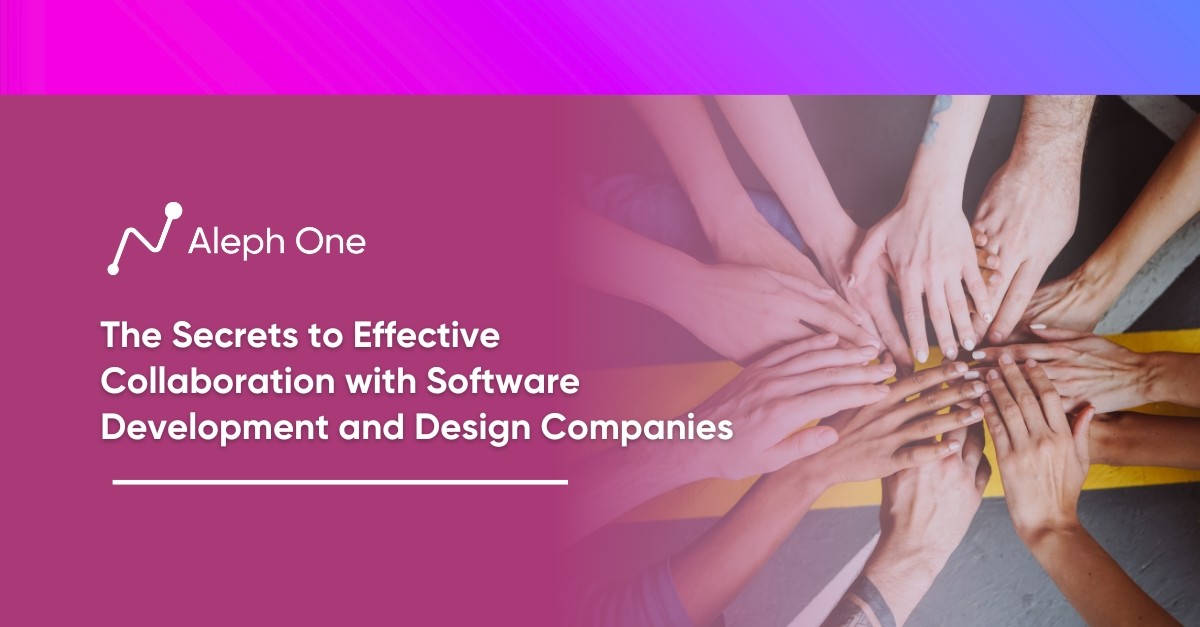Let’s work together to build something amazing. Share your project details and our team will reply to figure out the next steps to your success.

The journey from the inception of software development to its current state, marked by agile methodologies, open-source collaboration, and cloud-based innovations, has been remarkable. Over the past 70 years, the software landscape has shifted profoundly from the rigid Waterfall methodology to the dynamic Agile approach. This article explores the history, the principles of effective collaboration, and the future trajectories that guide the nexus of software development and design, uncovering the secrets to fostering productive partnerships.

The Evolution of Software Development: How We Got Here
Software development has a long and storied history spanning more than 70 years. In the 1950s, software was developed using the Waterfall methodology, where development flowed sequentially through planning, design, implementation, testing, and deployment phases. This approach worked when the software was simple, but Waterfall proved too rigid and slow as it grew more complex.
Agile Techniques and Cross-functional Teams
In the 1990s, faster and more flexible methodologies like Scrum and Extreme Programming emerged. These Agile techniques focused on iterative development, collaboration, and adaptability. Instead of strict planning upfront, Agile methodologies embrace changing requirements and continuous improvement. Cross-functional teams work together in short sprints, building and releasing software in increments.
Open-source Software and Cloud Computing
Open-source software and cloud computing also revolutionized the industry. Developers can collaborate and build on each other’s work when openly sharing source code. Cloud computing offers on-demand access to computing services over the internet, enabling rapid scaling and deployment. These innovations made developing and releasing software faster and easier than ever.
Agile Methodologies, Open-source tools, and Cloud Platforms
Today, most software is built using Agile methodologies, open-source tools, and cloud platforms. Short release cycles of 1-4 weeks are common, a far cry from the 6-24 month cycles of the Waterfall era. Collaboration between developers, designers, and business stakeholders is essential. Continuous integration and continuous delivery pipelines allow code changes to be built, tested, and deployed automatically.
Automation and New Models
The software development field continues to evolve rapidly. Artificial intelligence, blockchain, quantum computing, and self-driving cars are just some emerging technologies that will shape the future. Software development will become more automated, with AI handling some coding and testing. Blockchain may enable new models of secure collaboration and crowd-sourced development.
The software development industry has made huge leaps in the last 70 years. Advancements in methodologies, tools, and technologies have enabled developers to build increasingly sophisticated software at an accelerated pace. The future is bright, with no shortage of opportunities for continued progress. Staying up-to-date with the latest trends and innovations will be crucial to success.
Design Thinking: Understanding Your Users and Their Needs
Design thinking is a crucial approach for building software that people want to use. It puts users at the center of the development process through empathy, ideation, and user experience design. By understanding users’ needs, teams can solve the right problems and create solutions tailored to their customers.
Developing Empathy for Users Through Research
The first step in design thinking is developing empathy for your users through research. Teams conduct user interviews, observe target users in their environment, and create personas representing key user groups. Journey mapping also helps to understand a user’s experience with a product or service. These techniques provide insights into users’ motivations, behaviors, pain points, and unmet needs.
Deep Understanding of Users
With a deep understanding of users, teams can ideate by brainstorming many possible solutions to their problems. They then evaluate and filter these ideas to determine the most promising options. Concepts are turned into rough prototypes that can be tested and refined based on user feedback. This iterative process results in desirable, feasible, and viable solutions.
User Experience Design
User experience design also plays a key role in software development. Information architecture, interaction design, and interface design all influence how easy and enjoyable a product is to use. Simple and intuitive experiences are crafted through wireframing, prototyping, and usability testing. UX designers consider how users can complete tasks, access information, and interact with an interface in the most straightforward way possible.
By applying design thinking, teams build a continuous feedback loop with their users. At each stage of development, solutions can be evaluated and improved to meet customer needs better. Design thinking leads to software that provides an excellent user experience, delivers real value, and fosters loyalty and engagement. When people’s needs are prioritized, the result is a product they genuinely want and are eager to adopt.
The Power of Collaboration: How to Work Together Even When You’re Apart
Collaboration is essential for building great software. As teams have become more distributed, collaboration has become more challenging and critical. Effective collaboration allows teams to share knowledge, gain new perspectives, build consensus, and achieve better outcomes together than they could individually.
Establish a Culture of Collaboration
For software teams, especially those separated geographically, it is important to establish a culture of collaboration. This starts with frequent and open communication using tools like video conferencing, messaging, and document sharing. Teams should overcommunicate by default, documenting discussions and decisions and sharing updates.
Pair Programming
Pair programming is a highly collaborative technique in which two developers work together on the same workstation. Screen sharing and voice chat can enable a similar experience for distributed teams. Pairing leads to shared knowledge, mentoring, and higher-quality code.
Collaborative Design and Brainstorming Sessions
Collaborative design and brainstorming sessions help teams solve complex problems. Using digital whiteboards, teams can come together to map out ideas, user journeys, and product designs. These synchronous working sessions, even for remote teams, generate innovative solutions through discussion and ideation.
Code Review
Another collaborative practice is code review, where developers evaluate each other’s code. Code review leads to learning, higher quality code, and more maintainable software architecture. For remote teams, pull requests on platforms like GitHub and video chat enable effective code review.
Teams Must Seek Out Different Perspectives
To collaborate well, teams must habitually seek out other perspectives. This could involve asking a designer for user experience input or a product manager to review a technical specification. Broad collaboration beyond a team’s immediate scope leads to solutions that address the right problems and work well for end users.
With the right culture and tools, software teams can achieve a high level of collaboration, even when working distributed. An emphasis on shared knowledge, open communication, and broad collaboration enables teams to work cohesively to build solutions people need and want to use. Overall, collaboration is what turns a group of individuals into a team.
Agile Principles: How to Build Software People Love
Agile software development methods like Scrum, Lean, and Kanban are based on a set of core principles that enable teams to build high-quality software and systems. The first principle is iterative development, where software is built in increments over multiple short cycles. This allows teams to adapt to changes, get feedback, and deliver working software faster.
Collaboration is Key
Agile teams are cross-functional, self-organizing, and focused on face-to-face communication. By working together closely, teams can solve problems faster and build on each other’s ideas.
Agile Teams Value Adaptability
They embrace change and are able to quickly adjust their plans and priorities based on customer feedback or new insights. Nothing is set in stone, and teams stay flexible and open-minded.
Continuous Improvement is an Important Principle
Agile teams constantly look for ways to become more effective and efficient. They inspect and adapt, evaluate what’s working, and make small adjustments to optimize their productivity and outcomes.
When organizations adopt these principles, the benefits are significant. They are able to achieve faster time to market by releasing software in short, frequent cycles. They build higher quality products that better meet customer needs thanks to constant feedback and adaptation. Teams report higher job satisfaction, morale, and productivity. Businesses benefit from improved customer satisfaction, a quicker response to change, and a competitive advantage.
To become an Agile organization, companies must transform their culture and processes. They reorganize teams, change how they plan and manage work, adopt new collaborative tools, and provide Agile training and coaching. The transition can take time, but adopting Agile principles and practices helps companies create software and systems that users love. Overall, Agile leads to better outcomes for both customers and businesses.
DevOps: How to Deploy at the Speed of Light
The DevOps movement emerged to break down silos between development and operations teams. DevOps enables continuous integration and continuous deployment, allowing organizations to build, test, and release software rapidly, frequently, and reliably.
DevOps Tools and Techniques
DevOps leverages tools and techniques like version control, automation, and monitoring to streamline the software development lifecycle. Version control systems like Git allow developers to collaborate on code and track changes. Automation tools like Jenkins, Ansible, and Chef automate the build, test, and deployment processes. Monitoring tools give developers visibility into the performance and health of applications.
Deploy Updates Frequently
With DevOps, developers can make small application changes and deploy updates frequently, even multiple times daily. This is a vast improvement over traditional methods where developers released software infrequently and changes were large and risky. Frequent, incremental updates reduce risk and allow organizations to adapt quickly to feedback.
Developers and Operations Culture of Collaboration
DevOps also emphasizes a culture of collaboration between teams. Developers and operations engineers work together closely, sharing responsibilities and combining workflows. This helps to address issues quickly and avoid finger-pointing when problems arise.
DevOps Significant Benefits
When implemented well, DevOps offers significant benefits. Organizations can deploy new software features faster to gain a competitive advantage. They can also fix bugs and security issues quickly to reduce risks. DevOps enables a data-driven approach to software development through extensive monitoring and metrics.
Downsides of DevOps
However, achieving DevOps can be challenging. It requires rethinking long-held beliefs and reorganizing teams around shared goals. Automating processes requires investment in tools and resources. It also demands continuous learning to keep up with evolving technologies.
For organizations that make the effort, DevOps is a game changer. It allows them to build software that delivers value to customers and the business at a speed and quality nearly impossible just a decade ago. Adopting DevOps principles is critical for any organization that wants to compete in today’s software-driven world.
The Future of Software: What’s Next?
Software development is an ever-changing field, and the future is filled with exciting possibilities. Emerging technologies like artificial intelligence, blockchain, and quantum computing are already making their mark on the software industry and will continue to shape development in the coming years.
Artificial Intelligence and Machine Learning
Artificial intelligence and machine learning can automate and optimize many of the tasks software developers perform. AI can analyze requirements, generate code, find and fix bugs, and even deploy updates. While human developers aren’t going away anytime soon, AI will likely take over many routine coding and testing tasks, allowing developers to focus on more complex challenges.
Blockchain Technology
Blockchain technology allows for secure, transparent, and decentralized data storage and promises to revolutionize software platforms, applications, and even development. Blockchain enables new digital interaction models without the need for a central authority. From supply chain management software to electronic voting systems, blockchain will likely transform software in nearly every industry.
Quantum Computing
Quantum computing will give software developers access to incredibly powerful machines that operate fundamentally differently than today’s computers. This could solve some intractable issues for classical computers, like complex optimization, machine learning, and predictive modeling. Software developers must learn new skills and thinking methods to build quantum algorithms and applications.
Emerging Technologies
The self-driving car is a prime example of an emerging technology that relies heavily on software. Autonomous vehicles require advanced software for perception, mapping, navigation, and vehicle control. Developing this software requires skills like computer vision, sensor fusion, and deep learning. Self-driving cars are just one of the many exciting robotics and embedded software projects on the horizon.
Take Your Startup Forward with the Latest Software
The future of software is bright, but developers and organizations must keep up with the pace of change. By staying on the cutting edge of emerging technologies, the software industry can build a future of innovative platforms, applications, and solutions we can’t even imagine yet. The possibilities are endless.
FAQ
As software development methodologies have evolved, how has this impacted daily operations within software development companies and team?
The evolution of software development methodologies has dramatically impacted daily operations within software development companies. The shift from Waterfall to Agile techniques has replaced rigid structure and sequential development phases with flexibility, ongoing improvements, and iterative development. The daily routines now often focus on short sprints with constant feedback loops, considerable collaboration, and cross-functional team integration. Agile methodologies have sped up release cycles, with common practices being continuous integration and frequent deployment. There is now a greater emphasis on proactivity, adaptability, and finding quick, innovative solutions.
How have Agile methodologies and elements such as design thinking and collaboration helped companies navigate the increasingly user-centric approach to software engineering?
2. Agile methodologies and components like design thinking and collaboration have been instrumental for companies to focus more on the user in software engineering. Agile’s emphasis on iterative development and regular feedback gives greater room for user input and adjustments based on this input. Design thinking promotes a user-centric approach, aiding in the deep understanding of users’ needs, and leading to the development of the most suitable solutions. Collaboration ensures a greater diversity of ideas, skills, and experiences in solving problems and innovating. Agile, design thinking, and collaboration combined have enabled companies to continually adapt to user needs and expectations, improving user experience and satisfaction.
What are key skills software developers should acquire to thrive in the constantly evolving software industry, especially regarding emerging technologies like artificial intelligence, blockchain, or quantum computing?
To thrive in the constantly evolving software industry, it’s crucial for developers to adopt a mindset of continuous learning and adapt to emerging technologies. Knowledge of artificial intelligence is vital as it is becoming an integral part of various functions, from coding to testing. Blockchain technology is also gaining prominence, demanding developers understand secure, decentralized data storage. Familiarity with quantum computing becomes significant with its potential to solve complex problems and transform software applications. Additionally, skills in areas like computer vision, sensor fusion, and deep learning can be beneficial, considering the rise of projects involving robotics and embedded software development like self-driving cars. Therefore, staying abreast of these technological changes and acquiring new skills will be key for developers.
Get the latest news and updates from Aleph One in your inbox.



